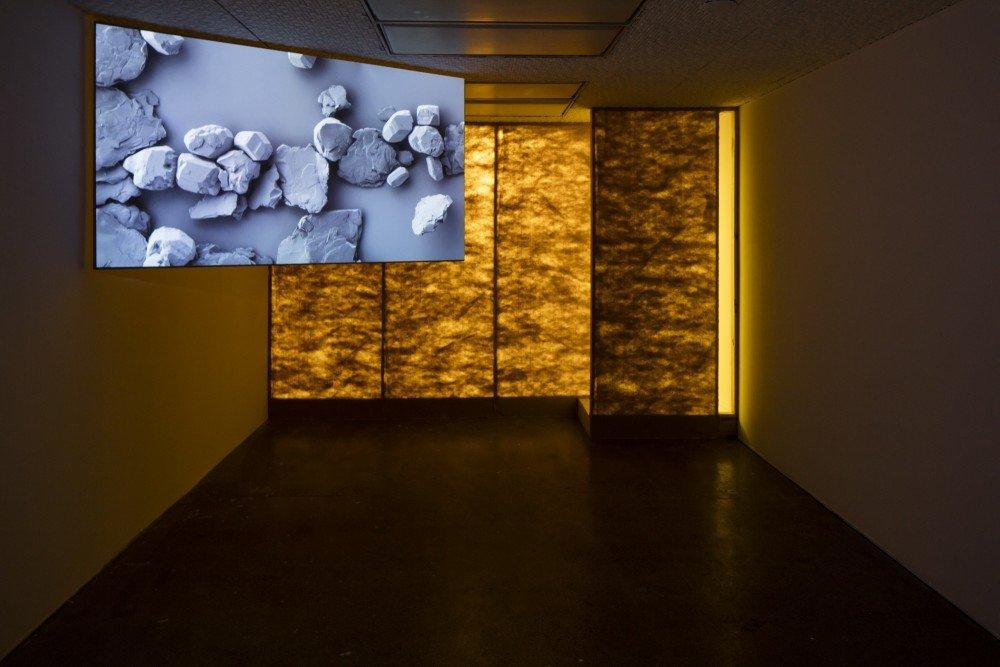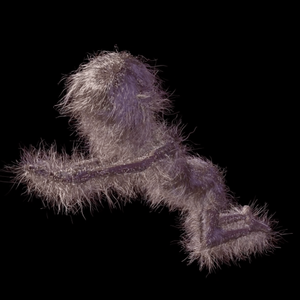I found myself turning, quickly looking over my shoulder, then turning around again whilst viewing Los Angeles-based Martine Syms’ Notes on Gesture (2015). Its four channels played on four monitors, mounted onto slim black poles in a circular formation, before a corner of empurpled walls. In the video, African American actor Diamond Stingily appears in a studio, before a purple drop, the frame is closely cropped to show her head and shoulders or sometimes merely an arm or hand. Stingily performs a series of gestures which are then heavily edited and looped so that they repeat like a Vine or GIF or as though they have been pre-programmed into a synthesiser. There is a hair toss, a hand-clap, rolling of eyes, hands put together in prayer, an admonishing wag of a finger.
A disquieting effect was created, for as soon as one viewed a screen, one could hear utterances emanating from another, and an upon spinning around to witness what was happening, one was just in time to see the image change again. The display of this multi-channel video on different screens meant that it was impossible to see the work in its entirety, its installation goes some way to displace whoever is viewing it. Such disorientation produced a feeling of being-other or outside of something, perhaps even de-centring those who would normally enjoy dominant or privileged subject positions. Syms’ use of rhythm and repetition makes the work seductive and irresistible, yet it also provides resistance, it cannot easily be followed or read. The slick repetition of words and gestures within the work, the seemingly infinite iterability of each utterance and gesture made them seem slightly absurd. Sym’s actor plays a particular type, one with a specific, racially-inflected way of moving and speaking. These specific ways of moving and speaking make up a vernacular or aesthetic, one that has slowly formed over time and been appropriated, re-appropriated and disseminated by black bodies in performance and in print-based, cinematic, televised and digital media.
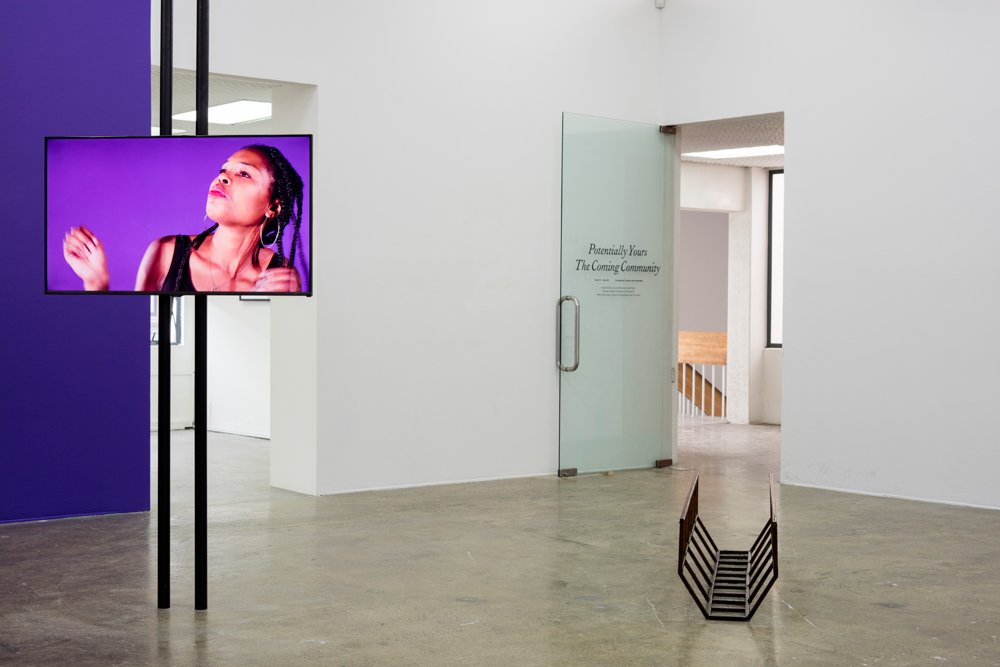
Installation view of Notes on Gesture (2015) Martine Syms, four-channel HD Video. Photographer: Sam Hartnett. Courtesy of the artist and ARTSPACE
Syms’ video was the centrepiece of the exhibition Potentially Yours, The Coming Community curated by ARTSPACE Curatorial Assistant Tendai John Mutambu 10 November 10 – 22 December 2016. The title of Syms’ work is taken from an essay by Italian philosopher Giorgio Agamben, sharing a concern with the possibility of creating studies or even pathologies of gesture.(1) According to Agamben, gestures belong within the "sphere of action", and it is gesture that opens up "the more proper sphere of that which is human." Most relevant for Syms’ work, in the context of Mutambu’s exhibition, is the gesture as a gag, something that communicates a communicability, yet is also "a gesture of not being able to figure something out in language." A gag involves the "appearance of that which cannot be said."
Although the reference to Agamben is explicit, also evoked is Judith Butler’s argument about how identities can be tenuously constituted over time, through the public and stylized repetition of certain acts, forms of behaviour or gestures. Butler argues for the construction of gender, however the same might be said of ethnic or even more intersectional identities. In terms of the materiality of gesture, in some ways it is light, flippant and totally ephemeral, but Syms points to the way in which a gesture might be part of what Butler calls a "corporeal style"(2), each gesture is weighted with its own history and cultural construction over time, corresponding to the point that any social agent is the "object for" rather than the "subject of" acts that make up a certain identity.
Potentially Yours, The Coming Community is an ambitious instance of research-based exhibition-making that consists of a series of very strong works. Its constellation of concerns includes, as the title suggests, alternative approaches to and new understandings of potential. On the one hand such potential may be a late capitalist drive towards "living up to potential" or self-optimisation. On the other, there is also the potential for critical imagining otherwise and the possibility for an empowered or resistant not-doing.
The exhibition’s title begins with a farewell greeting, its addressee unknown. What is communicated is a sense of reticence, even coyness. And such a greeting emanates from an entity known as "The Coming Community", a phrase also utilised by Agamben for one of his publications(3). Crucially, at the start of one of the essays from the same text is the sentence: "The coming being is whatever being." So part of being a community that is coming is to be "whatever". This might mean whatever in the sense of apathy, a declaration of "no matter" or "I couldn’t care less" as well as "whatever" as in the "anything goes" of radical potentiality.
One way of interpreting the exhibition is that it investigates potential temporalities and materialities as well as a seemingly infinite potential or even imperative to perform. Performance can mean efficiency, efficacy and success, though it can also mean a public display of behaviour. Thus Potentially Yours, The Coming Community can be read as a series of vibrations between: self-optimisation and resistance; dedication and reticence; acquiescence and imagination as well as apathy and potentiality. All of these tensions are complexified by Mutambu’s assertion that the works within this exhibition also address "political ecologies, inhuman subjectivities, the archive, racialized temporalities and the chronopolitics of labour and leisure."
In the same space as Sym’s Notes on Gesture is a newly-commissioned work from Auckland-based artist Dan Nash. Both works enjoy specific types of objecthood, however, where Sym’s meticulously-installed monitors punctuate space and force one to interact with them in the round, Nash’s Plant them in, kill off thinking is a unique melding of installation, painting and text. The work is a series of robust and slightly crusty welded steel structures that appear to be modular- part grid, part cage. From wall and floor, two of the structures act as supports for digital prints on aluminium panels. Each panel bears texts as well as images made up of paint-like material that has been manipulated to form dark landscapes of swirling, primordial vortices and upswept, cavernous turrets. Nash combines a considered mode of display with a rarefied process of image-making, as well as the modalities and potentiality of fiction. Poetry and prose are used to conjure up a cosmological odyssey through an oceanic environment shaped by extreme weather patterns and teeming with a myriad of life forms.
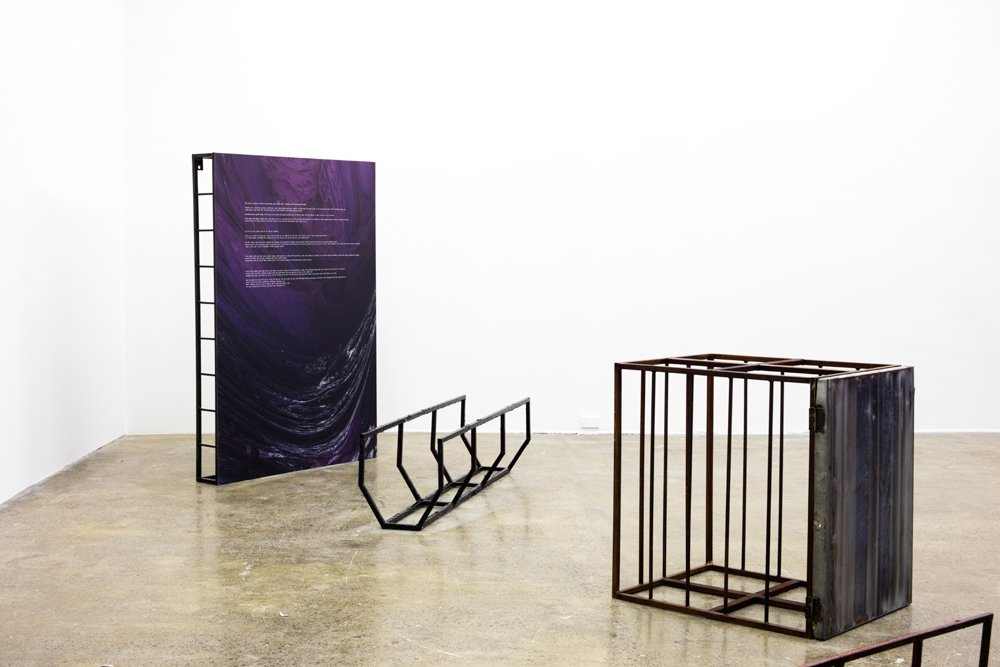
Installation view of Plant them in, kill off thinking (2016) Dan Nash (new commission), digitally rendered prints on aluminium, steel framing, resin. Photographer: Sam Hartnett. Courtesy of the artist and ARTSPACE
Just as Nash utilises specific structures, technologies and writing to explore the potential of objects, fellow Auckland-based artist Sorawit Songsataya uses video and installation in order to explore potential materialities. As part of Coyotes Running Opposite Ways, Songsataya created a mini-environment or space within a space, inside of the gallery. In his installation, a row of felt-like blankets in garish colours, part animal print, part korowai hang from a wall, so that they are readily at hand. A jute wall, tinted lights and a wooden floor divide the space and provide a warm and cosy environment. Within the sunny, wooden space sits a tepee-like shelter, one constructed from wooden branches and glazed ceramic twigs and dotted with woollen forms that appear like possum merino socks, or even toy-dog or fetus-sized sweaters. It is in close proximity to this almost cartoonish structure, a fort-like, sheltered place-within-a-space that the artist’s animated video appears projected upon a panel mounted close to the ceiling.
Songsataya’s animation clicks between the micro and macro. There are what appears to be various substances and fibres viewed through a microscope. They go in and out of focus and get darker or lighter as the aperture is changed. Prints taken from this footage then appear laid out upon a knitted surface on a black background together with what appears to be the same ceramic twigs the tepee has been partially constructed from. The aural accompaniment sounds sometimes like the tinkling of bells, sometimes like the sonic emissions of a submarine. A pair of hands dressed in a rainbow-striped jersey manipulate the objects so that the fabric moves accordingly. The animation creates layers of virtuality, different realities and ways of seeing, each with their own viewpoint and discipline. There is the hobbyist or manufacturer’s view of stockingette stitch, a scientific use of microscopic imaging, perhaps even a survivalist’s vision of the usefulness of wooden branches. However most importantly there is also a more cosmological and indigenous viewpoint as the video takes its title from the Navaho string figure it demonstrates. In another part of the video the same animated pair of hands hold up manipulated strings, sometimes before blackness, sometimes before a starry sky. There is something about the height of the videos’ installation that forces one to crane one’s neck up to look at it, as though also looking up to constellation in the sky. The animation Coyotes Running Opposite Ways communicates potentialities of materials along with their own potential narratives, beliefs and value systems.
Although deceptively simple, Sydney-based artist Newell Harry’s framed photograph and text, like Syms’ installation is a threshold moment in Mutambu’s exhibition. Untitled (Black Sabbath and Other Anecdotes) (2013) is a framed, black and white print with an accompanying text written with a type-writer. Harry’s anecdote recounts the phenomenon of so-called "island time", or the way in which one individual’s chosen non-conformity to expectations is interpreted by another party as irresponsibility. Similarly, the complexities of lassitude are explored in Harlem-based artist Mika Rottenberg’s video Time and a Half (2003). Alluding to or linking with Harry’s island, the crucial moment of this work is a hand, impatiently marking time by tapping fingernails adorned with tropical island nail art upon a pseudo marble counter-top. This lazy measure or casual quantification of time, by a young woman working within an Asian foodcourt stand goes some way to communicate duration or felt time. Patient/impatient, the subject of Rottenberg’s video stands enclosed within partitioned space, a docile body working, yet currently not working. The boredom involved in time as quantified, working time, one that accumulates in order to eventually deliver an hourly rate of pay, is communicated by Rottenberg by slowing the footage down. Boredom, with its accompanying protraction or suspension of time and its capacity to heighten the senses is realised by Rottenberg’s slowing down of videoed time. The young woman’s hair, blown by a fan, floats slowly around her head in long tendrils. An indoor plant gently nods, an illustrated scene upon a light box flickers and pulses. As in Songsataya’s work there are layers of virtuality, acrylic nails, possible hair extensions, impeccable make-up, "authentic" and exotic cuisine, an artificial plant, a generic landscape. The tension created by the accumulation of such time builds to a moment of delicious release, when time is sped up, and one by one, ridged paper plates fly away to the mirth of the young, working woman.
Another kind of potential temporality is evoked in Auckland-based artist Louise Menzies’ series of print works Time to Think Like a Mountain. Subsequent to research carried out in a Connecticut archive and continuing her interest in the ephemera created by certain fringe communities or groups, Menzies re-printed selections from various newsletters and magazines on handmade paper. Similar to Harry’s work, these extracts might be viewed with nostalgia or be slightly fetishized by their offset techniques, dated typography, sincere imagery and often single-colour printing. The content within the pages chosen by Menzies ranges from revolutionary politics, how to build your own log cabin, to a periodical known as Womanspirit and crucially The Right to Be Lazy. By bringing to attention such quaint and idiosyncratic material, Menzies alludes to the politics of archives, the decision-making involved in retaining certain objects rather than others.
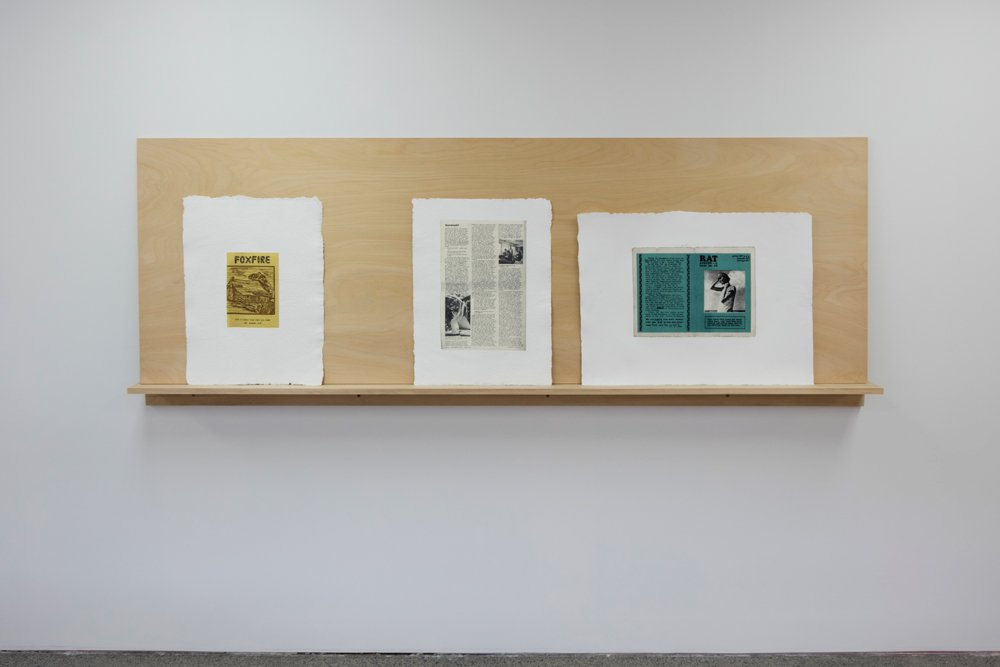
Installation view of Time to think like a mountain (2014) Louise Menzies, inkjet print embedded in handmade paper. Photographer: Sam Hartnett. Courtesy of the artist and ARTSPACE
For performance theorist Rebecca Schneider, too often the archive involves practices of "patriarchal conservatism."(4) Such decisions indicate certain values, some things are kept in the belief that they will be of use or interest sometime in the future while others are discarded. Menzies presents the traces of certain groups, the ways in which they communicate and hope to mobilise themselves. And yet on a different material level there is also the time involved in hand-making paper. Shredding, soaking… long processes of congealing, hardening and drying.
Finally, the video Mendeel Um A7mad (NxIxSxM) by New York and Berlin-based, Kuwaiti artists Fatima Al Qadiri and Khalid Al Gharaballi shares Menzies’ interest in the politics of gender and specific ways in which women meet or gather. In terms of potential uses of recreational or spare time, the work depicts four Kuwaiti women gathering for Chai Dhaha or morning tea. Performed by an all-male cast, the video presents a very particular usage of time, one in which to gather, comment and discuss. Four women sit like cardinal points of a compass in a luridly decorated hotel ballroom. Passive-aggressive, they subtly compete with each other: who is the most slender; the most wealthy; the most modest; who has the most generous husband and accomplished offspring? Just as in any iteration of the reality television series Real Housewives, Al Qadiri and Al Gharaballi’s video concerns the conspicuous display of material wealth, coupled with a deeply conservative adherence to traditional gender roles. Paradoxically, in this video such a mindset is gently undermined by the women’s portrayal by a male performer. Highlighting the different levels of engagement by different generations with technology is a particular moment when one of the women admits to barely knowing how to use the latest smartphone, using them only to communicate with their children; children whose lives and temporalities are shaped by the very same devices.
Perhaps it is mobility, rather than potentiality that is communicated by Mutambu’s group exhibition. Syms points to the mobility or circulation of gesture through various different bodies, from public figures, actors, models, musicians, teenagers and back again. Nash uses sculptural supports to shift languages of painting and to propose fictive modalities and imaginings. Songsataya deftly manipulates installation and animation techniques to mobilise objects of his own making from concept to actualisation, whether concrete or digital. Harry’s work recounts a prevention of mobility, a blockage which highlights contrasting ideas of time, liberty and responsibility. Menzies’ prints mobilise paper ephemera, retaining and capturing the original in order for it subsist over time. Mobility as a flexibility or ability to play multiple roles is portrayed in the videos of Rottenberg and Al Qadiri/Al Gharaballi. A young woman uses adornment and cosmetics to make herself glamourous whilst existing in the servile role of working in a foodcourt. One actor can play multiple genders and roles in conversation with each other.
Such flexibility can act like a filter, a way of seeing, an openness to different modalities and multiple narratives whether they be in the realm of astronomy, cosmology, science-fiction, poetry, gender and/or racial politics, labour or lifestyle. This returns to the central concept of potentiality, the potential to creatively imitate or repeat, the seemingly infinite potential to manipulate materials, the potential of playing a role, the potential to daydream or stop working, the potential to hold onto something that matters, the potential to imagine otherwise, or most importantly the potential of gesturing towards "whatever."
